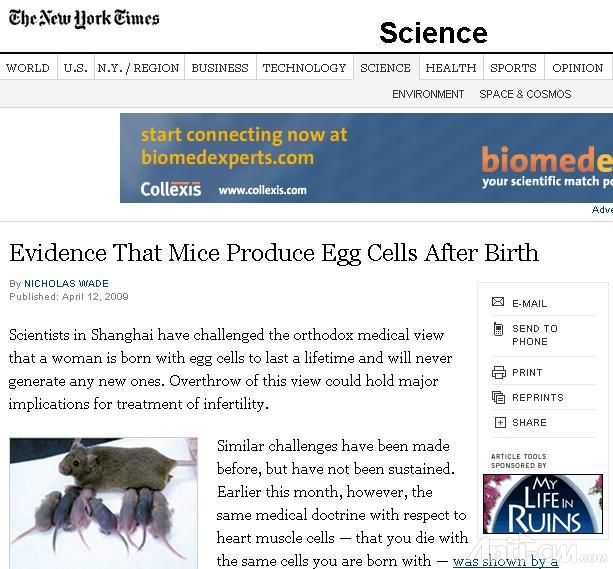本帖最后由 aha 于 2009-4-14 16:59 编辑
【原文标题】Evidence That Mice Produce Egg Cells After Birth
【译文标题】证据表明老鼠出生以后仍可产生卵细胞
【来源地址】http://www.nytimes.com/2009/04/14/science/14cell.html?_r=1
【译者】aha
【翻译方式】人工
【声明】本翻译供Anti-CNN使用,未经AC或译者许可,不得转载。
(这个成果英国卫报也做了报道,
http://www.guardian.co.uk/science/2009/apr/12/stem-cell-female-infertility-claim
标题为
科学家表示,干细胞研究为不孕症治疗提供了新的前景
Stem cell study may raise prospect of new fertility treatment, say scientists
而标题后的引言为
专家谨慎指出上海团队的研究是尝试性的并有待证实
Experts caution that Shanghai team's findings are tentative and need confirmation
总之,希望这次的成果不是一次虚张声势。科学家们,给我们点信心吧。)
证据表明老鼠出生以后仍可产生卵细胞
正统的医学观点认为女性先天的卵细胞会伴随女性的一生,并且后天不会生成新的卵细胞。来自上海的科学家们挑战了这一观点。这一挑战或许会带来不育症治疗的重大进展。
类似的挑战过去也有过,但都没能维持下去。本月早些时候,同样一篇关于心脏肌肉细胞(和卵细胞一样先天生成,维持一生,后天不能再生)的医学论文(作者是瑞典科学家Jonas Frisen)证明传统观点是错误的:心脏肌肉细胞确实有替换的过程,但十分缓慢,一年百分之一或者更少。
由上海交通大学Kang Zou和Ji Wu率领的中国团队只对老鼠进行了研究,不过鉴于所有哺乳动物生理学的相似性,任何老鼠能够在出生以后产生卵细胞的证据都会引发一场对人类同样功能的研究竞赛。
上海的研究者说他们工作的核心是对年轻年长老鼠的种系细胞进行了研究。种系细胞可以生产未受精的卵子,即卵母细胞。
研究者的报告发表在最新一期的自然细胞生物学杂志上(NATURE自然杂志的下属杂志——译者注)。他们扫描了老鼠的卵巢,寻找能够生产一种叫做vasa homolog(homolog,相同的事物——译者注)的蛋白质的细胞,而这种蛋白质目前只在种系细胞中发现。胚胎成型的过程中,这些细胞会生成所有的卵母细胞,而这些卵母细胞会在女性体内保留一生。
研究人员在老鼠的卵巢中搜寻出这些能产生vasa的细胞,将他们从卵巢中取出,放在实验室的试管中培植。在试管中被注入一种能产生绿色透明蛋白质的基因,这是标记细胞的标准方法。
然后研究人员将这些种系细胞注入一批自身卵细胞已死亡的老鼠的卵巢中。老鼠交配之后,一些他们的后代呈现绿色,这显示他们来源于由被注入的种系细胞所生成的卵细胞。
堪萨斯医学中心大学的繁殖专家David F. Albertini称这个结果颇令人兴奋,但他又说此实验很难被解释。他认为研究者取出的细胞中可能含有卵母细胞,虽然他们努力排除。而那些新出生的小老鼠可能就是卵母细胞产生的结果。
除非所有这些问题都被排除,不然此观察还不能做为临床使用,更不要说人类和老鼠之间的生理学差异还没有解决。Albertini博士表示。
Albertini博士还说关于这份上海的论文及早些时候在出生以后制造出卵母细胞的宣称(claim),自然杂志并没有咨询包括他自己在内卵巢专家网络的意见。
证明了心脏肌肉细胞在生命中不断产生的瑞典的研究者Frisen博士,说他还没能将自己的研究方法应用到卵母细胞上。他的方法是衡量放射性物质碳14的含量。这种碳14是在二十世纪六十年代进行的地面核试验中所产生,并持续存在于全世界的细胞的DNA中。通过测量每个细胞中碳14的含量可以确定他的产生日期。
Frisen博士说目前人体内的卵母细胞数量还不足以提供一个可靠的信号,等到他的技术的精敏性得到改进以后,他希望可以进行卵母细胞产生日期的研究。
Evidence That Mice Produce Egg Cells After Birth
Scientists in Shanghai have challenged the orthodox medical view that a woman is born with egg cells to last a lifetime and will never generate any new ones. Overthrow of this view could hold major implications for treatment of infertility.
Similar challenges have been made before, but have not been sustained. Earlier this month, however, the same medical doctrine with respect to heart muscle cells — that you die with the same cells you are born with — was shown by a Swedish scientist, Jonas Frisen, to be incorrect: the muscle cells do get replaced, though very slowly, at the rate of 1 percent or less per year.
The Chinese team, led by Kang Zou and Ji Wu of Shanghai Jiao Tong University, worked only with mice, but because of the similarity of all mammalian physiology, any proof that mice could produce eggs after birth would set off a race to prove that people could too.
In essence, the Shanghai researchers say they have detected, in both young and old mice, the germ-line cells that produce unfertilized eggs, or oocytes.
The researchers report in the current issue of Nature Cell Biology that they scanned a mouse’s ovaries for cells producing a protein called vasa homolog that is found only in the germ-line cells. During the embryo’s formation, these cells generate all the oocytes that will be needed over the female’s lifetime.
The researchers detected vasa-producing cells in the mouse ovaries, fished them out and grew them in laboratory glassware. There the cells were injected with a gene that makes green fluorescent protein, a standard way of marking cells.
The researchers then injected the germ-line cells into the ovaries of another batch of mice whose own eggs had been killed. When the mice were mated, some of their offspring were green, indicating that they originated from eggs produced by the injected germ-line cells.
David F. Albertini, an expert on reproduction at the University of Kansas Medical Center, said the result was “a pretty exciting observation” but added that the experiment was difficult to interpret. He said that perhaps the authors had fished out a few oocytes, despite their efforts to exclude them, along with the germ-line cells, and that these oocytes could have been the origin of the infant mice produced later.
Until this and other issues have been sorted out, the observation is “not relevant clinically,” Dr. Albertini said, given the physiological differences between mice and people.
Dr. Albertini also said that in publishing the Shanghai paper and earlier claims of oocytes being produced after birth, Nature had neglected to seek the advice of a network of ovarian experts, including himself.
Dr. Frisen, the Swedish researcher who proved that heart muscle cells were generated throughout life, said he had not yet been able to apply his method to oocytes. His approach is to measure radioactive carbon-14, which was generated by aboveground nuclear tests in the 1960s and for years could be found in the DNA of cells throughout the world. The amount of carbon-14 in each cell type indicates its birth date.
Dr. Frisen said that there were not enough oocytes in a person’s body to give a reliable signal at present but added that he hoped to study oocytes’ birth date when he had improved the sensitivity of his technique.

|